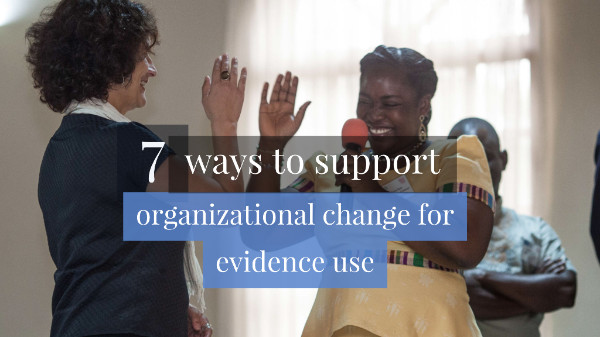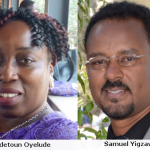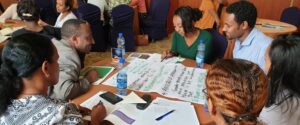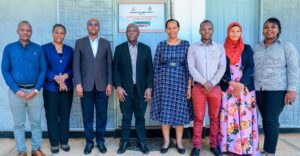
Seven ways to support organizational change for evidence use
Ruth Levine, the Chair of 3ie Board of Directors and director of the Hewlett Foundation’s Global Development and Population Program, closed the 3ie London Evidence Week one-day conference in November by speaking powerfully on the moral case for evidence in policy making. She called on evidence enthusiasts to ensure that the way they conduct and use impact evaluations reflects a larger moral aspiration toward truth, distributive justice, and human progress.
It was enlightening to be reminded of why we are doing this job. For me, the big question is:
How can evidence enthusiasts promote the value of knowledge in a way that helps bring about positive change?
I think the answer comes through meeting end users half way, by letting go of our own way of understanding the world, by listening actively and deeply and by collaborating in a more meaningful way. If we want public leaders and institutions to change, we, the international community, need to change first.
Looking at the whole picture
Projects to support evidence use in governments unfailingly involve getting deeply embedded in difficult contexts. By this I don’t just mean developing-country contexts but political and organizational contexts anywhere in the world. Perhaps the main takeaway of my past five years working with public institutions is that evidence use is part of something greater and if we don’t look at the big picture of policy making then we are bound to lose our purpose.
This is where INASP’s work around organizational change comes in. We know that looking at policy-making institutions in an integrated way (i.e. paying attention to organizational culture and motivations for evidence use, not just the systems and processes) can shed light into organizational weaknesses that are not easy to solve. Although difficult to address, if these weak spots are not acknowledged then the space to introduce evidence gets even narrower.
In our experience, blockages for positive change usually come from the not-so-easy-to-grasp factors like culture, values and perceptions. These factors are incredibly sensitive in any organization but more so in the public sector because the values and interests at play give shape to bureaucracies with limited will to openly admit failure, to learn and to adapt. These contexts create limited space for innovation and development.
This means that external actors like us can’t possibly embark on a project with a fixed agenda of what the problem is and what tool we will use to fix it.
When discussing these ideas with donors, I have been asked: “so what is it that you offer”? I wonder if they expect me to say: “a course for developing skills for evidence use”. While we do have training tools available, that’s not what we want to “sell” from the start. Instead, our approach is to bring facilitation skills that enable people to work out problems by themselves. Without a fixed agenda, we support the organizations we work with to identify the areas to prioritize for improvement and to support their teams to develop realistic action plans. If the needs analysis and organizational strategy shows they need a course to develop skills, yes, we can offer that, But sometimes organizations might need specific skills development beyond what our team can offer; that’s when we bring in partners – ideally local partners.
So far, the international community has offered a solution-based approach to institutional reform and capacity building. And I can understand why we got to this approach. It is very difficult to meet the demands from donors that require detailed three-year plans designed in advance, together with ambitious, predefined and measurable outcomes. Unless we are dealing with simple and linear problems, we know now these requests are difficult to meet. If we want to make a difference then it’s time for international agencies to work in a more integrated way that truly recognizes the unique context and needs of the organizations we are supporting.
Here are seven ways to support organizational change projects:
- Encourage learning and flexibility
- Build a vision of leadership and support
- Support locally defined and locally led initiatives
- Review risk and procurement policies; they often restrict flexibility and adaptability for programme design
- Design monitoring and evaluation methods for complex problems, not for linear ones
- Broaden the type of evidence that is valued to measure results; in complex and fluid environments linear methods can’t capture change
- Stick to what is good enough; the context will define what is possible
In summary: let’s let go of control and fixed agendas. Taking this seriously has huge implications for everyone involved in the development sector. We have built an international system of indicators, measurement and accountability that works very well for certain development issues but not for the complex, multilinear and fluid challenges we face right now. It is time to ask ourselves if we’ve gone too far and detached ourselves from the purpose of those and if they still fit and support organizational change. Let’s start by turning the camera back and looking at ourselves first.

 Previous Post
Previous Post Next Post
Next Post



Good insights. It is important to note that organizations are dynamic and living “organisms” that change according to the systemic environment. The evidence agenda must not be static but flexible enough to respond to the dynamism of organizational culture and systems.
Most organizations are operating in what has been termed a “VUCA” environment ( volatile, uncertainty, complex, unambiguity) which sometimes make it an arduous task in supporting/ promoting evidence use at the organizational level.
Over the last few years, I have learned that promoting and facilitating an evidence-informed approach in organizations requires diverse skills set which include both hard and soft skills such as negotiation, networking, relationship building, and facilitation. Strategic plans/ documents, work plans have become the key source which you are availed by most organizations in seeking to promote evidence use at the organisational level. However, it’s unfortunate that most of these documents are forward-looking and not focusing on the “now”. (this sometimes pose a serious challenge).
I certainly agree on the need for local driven iterative approaches in facilitating/ promoting the use of evidence at all levels. The key question which we have been grappling with over the last few months, is on what sustainable systems or processes can be put in place to change the organizational culture ( with regard to evidence use) given the different contextual environment in which organisations operate?